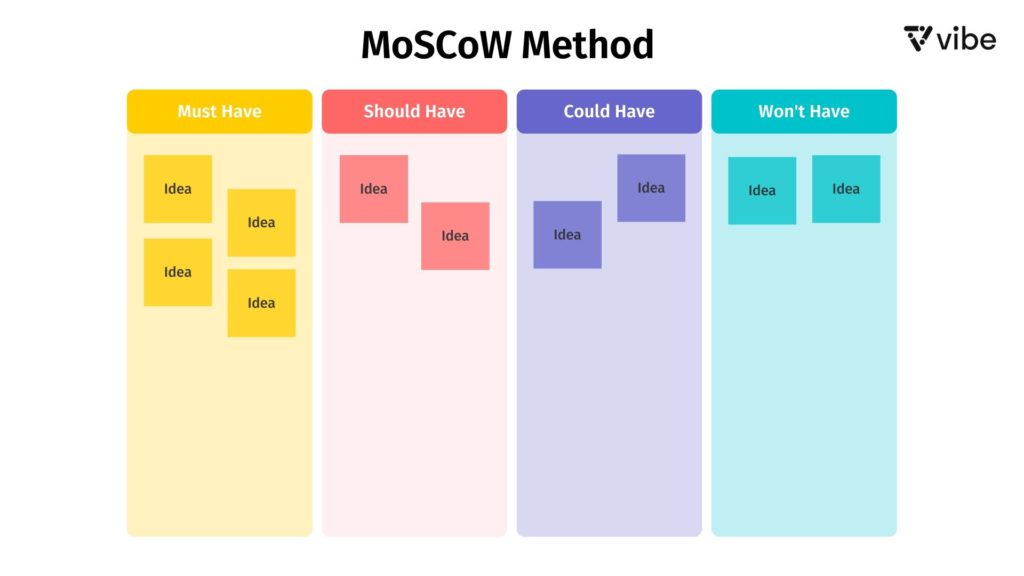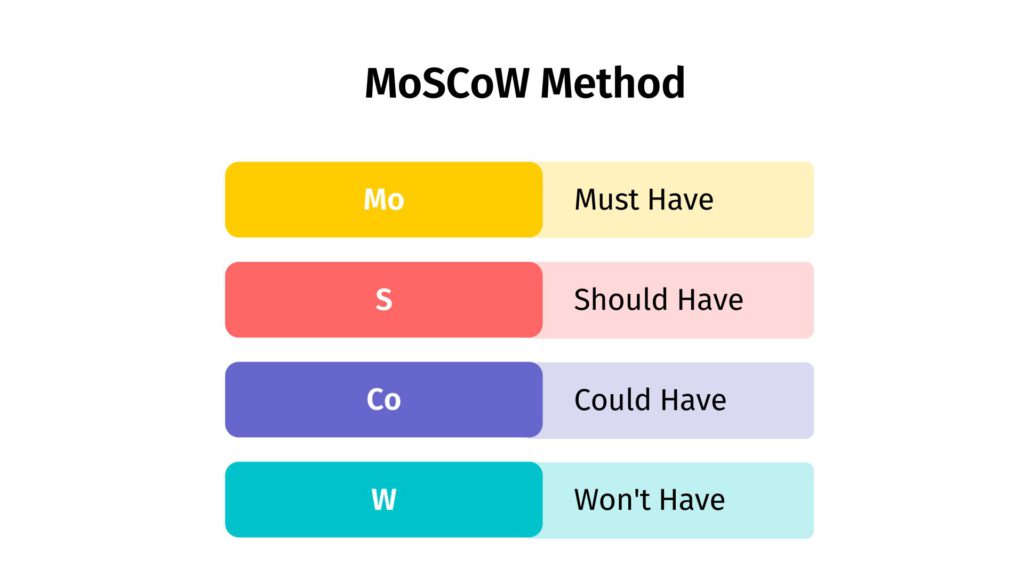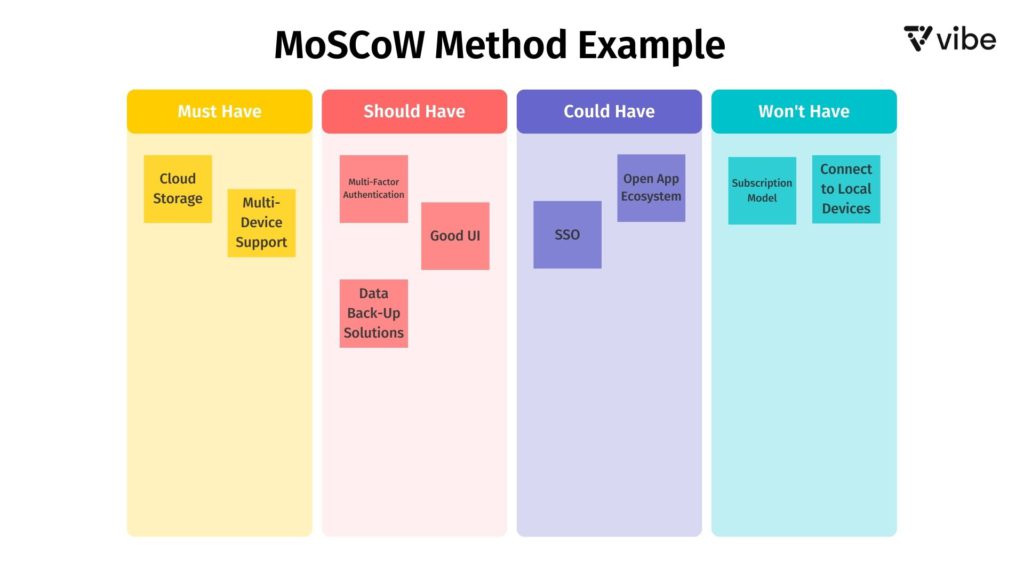Organization and prioritization are two key components of a successful project. They’re also elements that are inherently more difficult to achieve online. Luckily, tools like the Moscow Method are changing that.
The Moscow Method is a technique for teams to brainstorm and collaborate and has excellent takeaways that can be applied to a wide range of projects.
This blog provides a deep-dive into the Moscow Method and what makes it so beneficial to teams. Most importantly, we’ll also look at how to use an interactive whiteboard device like Vibe to get the most out of every Moscow Method analysis.
{{< blog/cta-download-new content=”S1 Buyers Guide” extra=”false” pdf=”https://vibe.us/pdf/S1-buyers-guide/?utm_campaign=moscow-method&utm_medium=blog&utm_source=blog”>}}
What is MoSCoW Method?

When you first hear about the Moscow Method, it probably invokes images of the Kremlin, Red Square, and St. Basil’s Cathedral. However, the truth is that the Moscow Method has nothing to do with Russia.
In fact, it was introduced by software developer Dai Clegg in 1994. In reality, MoSCow represents the acronym MSCW. Vowel sounds have been added to make it sound cool!
Every letter in MoSCoW stands for a different layer of task or project prioritization: Must, Should, Could, and Won’t.

By organizing tasks into the above categories, a team enjoys clarity on what it needs to focus on immediately and in the future.
Below is a detailed analysis of the type of tasks that fit into each category:
M – Must Have
The success of a project depends on these items. They must be included since the project would be pointless without them. In other words, this is a top Moscow requirement.
Below are a few prompting questions to ask in this category:
- What elements are truly necessary and irreplaceable?
- If ignored, would the project still serve its intended purpose?
- Will the project’s delivery be successful without this feature?
S – Should Have
Unlike items in the Must-Have category, these are things that are vital but not absolutely necessary. Items in this category are deemed a secondary priority. In short, they’re key but not crucial to success.
Below are a few prompting questions to ask in this category:
- How does this feature stack up against the must-haves?
- What’s a helpful but optional feature?
- What would happen to the project if this feature was overlooked?
C – Could Have
Although having these things would be nice, they’re not necessary. These items are regarded as a third-level priority because they’re still not as crucial as the first two categories. They should be excluded if having them will increase costs or make it harder to achieve deadlines. In short, they can be added only when they don’t adversely influence other project components.
Below are a few prompting questions to ask in this category:
- What additional tool, if any, would be beneficial but not a priority?
- What feature would you wish to include in the future?
- What effect would this feature have on the whole project?
W – Will Not Have
These items are unnecessary and can be left out of the project without endangering its success. Since they fall under the lower-priority category, ignoring them won’t jeopardize the project, and they can be added when the project conditions are more favorable.
Below are a few prompting questions to ask in this category:
- What features will be purposely omitted from this project?
- What is being postponed or avoided for a future release?
- Which features go beyond the purview of this release?
How Does the MoSCoW Method Work?

The Moscow Method essentially works by allowing team members to participate in project management discussions. This provides everyone with a comprehensive understanding of the organization’s operations and where their priorities lie.
Before you start conducting the Moscow Method, all team members must agree on which items will be prioritized. It’s also good to agree on how to handle conflicts to avoid delaying progress.
After establishing the framework, it’s time to start identifying the appropriate categories for every project. As we’ve already mentioned, these include Must-have, Should-have, Could-have, and Won’t-have.
For a better understanding of how the Moscow Method works, let’s see some examples.

Imagine a software development department designing a cloud-based workspace for individuals to improve their workflow. They are deciding which features are most critical, which would be nice, and which possibly won’t make it into this release. They agree that cloud storage is a must-have item since, without it, they would entirely miss their target. Once they have defined the must-haves, they then proceed to the should-haves. The should-haves are prioritized based on their importance. Lastly, the remaining tasks are categorized as either could-haves or won’t-haves.
What Are MoSCow Methods Used For?

The good thing with the Moscow Method is that it can be used in an array of situations, both in professional and personal contexts. For example, an individual could apply the method to prioritize their workload, or a team could use it to determine which tasks must be completed first to meet deadlines.
Also, if you’re launching a project and are hesitant about which elements should take precedence, you can assemble your team and employ the Moscow Method as a discussion or brainstorming tool.
Benefits of Using the MoSCow Method

Now that we have a firm idea of using the Moscow Method, let’s briefly go through some of its benefits.
Provides Direction
One of the key benefits of using a Moscow Method is the direction it offers to the project in question. When organizing features and tasks into several prioritized categories, the project begins to take shape.
Particularly with the addition of the “wont-have” section, the Moscow Method gets rid of the scope creep, a prevalent issue that arises when planning projects.
Scope creep is a word used to describe when new features and minor changes are added to a project, and as a result, the project grows to be more complicated than it was originally intended to be. Having a won’t-have section explicitly defines the futures that won’t be considered, which means there’s no ambiguity on the bigger picture of what to include.
Resource Division
Another benefit of using the Moscow Method is a clear division of resource allocation throughout the project. Having “must-haves” separate from “should-haves” and “could-haves” means your team can easily allocate resources to the items that are a top priority.
The division of resources is important when managing a large project since it clarifies everyone’s roles and deadlines.
Helps Build Consensus within Projects
The Moscow Method is extremely helpful to teams when resolving a mix-up about the project’s scope and priorities. It’s a visual tool that managers, stakeholders, and other team members can all take advantage of to gain a good understanding of the project in question. It’s also a handy tool that aligns team members toward their shared goals.
Using Vibe for the MoSCoW Method

When it comes to must-have features, there’s one can’t-miss: teamwork. Once you launch a Moscow Method in a shared interactive whiteboard tool like Vibe, you can brainstorm, drag and drop ideas, draw, write, and share feedback in real-time with anyone on your team—whether they’re in Moscow, New York, or Melbourne. Nothing beats the convenience and efficiency that comes with collaborating and brainstorming with an interactive whiteboard.
Here are some steps on how to start prioritizing using a Moscow Method:
- Start by creating a Moscow Method template on your Vibe Board and share it with your team. As we’ve mentioned, Vibe’s interactive whiteboard software, Canvas, allows you to plan, draw, sketch, and visualize ideas from any device or location.
- With your team, examine each item in your backlog and categorize them into the right template section. Achieve this by asking your team members to name the must-haves, should-haves, etc.
- As you proceed, ensure that your team reaches an agreement on each initiative. Use emoji reactions or voting tools to capture their feelings about each initiative in real time.
- Once your team has decided on the status of each initiative, you can sort the sticky notes by color, emojis, or votes if you want to further analyze your board.
- Use the completed Moscow Method template to ensure every team member is aligned on action items for your team moving forward.
It’s as easy as that. Try Vibe today for all your Moscow Method and prioritization needs.
FAQs
How many categories are in the Moscow Method?
There are four categories in the Moscow Method. These are Must-Haves, Should-Haves, Could-Haves, and Won’t-Haves.
